

Chin J Plant Ecol ›› 2025, Vol. 49 ›› Issue (3): 460-474.DOI: 10.17521/cjpe.2024.0097 cstr: 32100.14.cjpe.2024.0097
• Research Articles • Previous Articles Next Articles
ZHAO Hong-Xian1, LIU Peng1,2, SHI Man-Ying3, XU Ming-Ze4,5, JIA Xin1,2, TIAN Yun1,2, ZHA Tian-Shan1,2,*( )
)
Received:2024-04-03
Accepted:2024-08-23
Online:2025-03-20
Published:2024-08-26
Contact:
ZHA Tian-Shan
Supported by:ZHAO Hong-Xian, LIU Peng, SHI Man-Ying, XU Ming-Ze, JIA Xin, TIAN Yun, ZHA Tian-Shan. Effect of leaf nitrogen allocation on maximum net photosynthetic rate of two common sand-fixing species, Artemisia ordosica and Leymus secalinus, in Mau Us Sandy Land[J]. Chin J Plant Ecol, 2025, 49(3): 460-474.
Add to citation manager EndNote|Ris|BibTeX
URL: https://www.plant-ecology.com/EN/10.17521/cjpe.2024.0097

Fig. 1 Daily means or sums of environmental factors in the study site in 2021. PPT, precipitation; REW10, 10 cm relative extractable water content; REW30, 30 cm relative extractable water content; SWC10, 10 cm soil water content; SWC30, 30 cm soil water content.
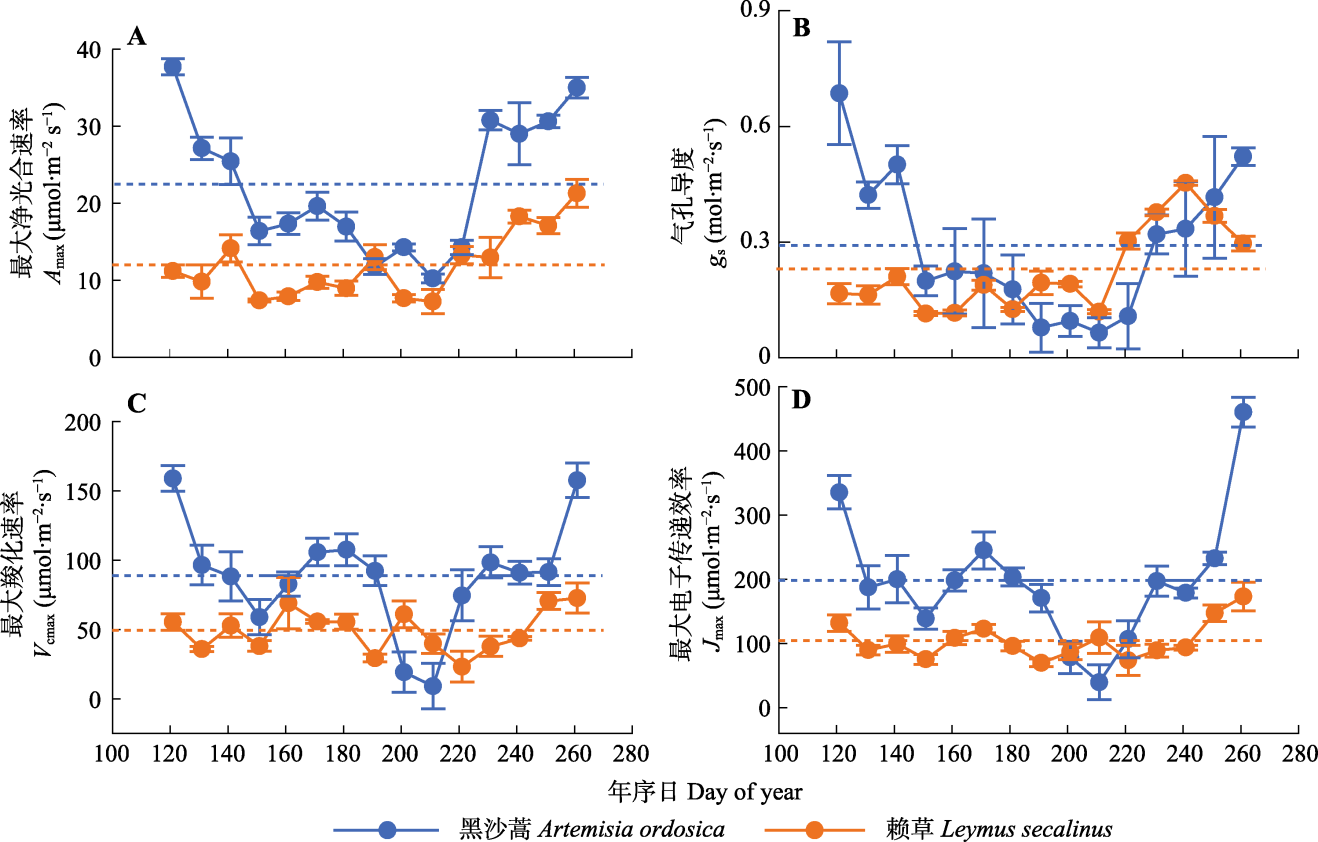
Fig. 2 Seasonal dynamics of leaf photosynthetic parameters in Artemisia ordosica and Leymus secalinus in Mau Us Sandy Land in 2021 (mean ± SD). The horizontal lines represent the mean values. Amax, the maximum net photosynthetic rate; gs, stomatal conductance; Jmax, maximum electron transport efficiency; Vcmax, maximum carboxylation rate.
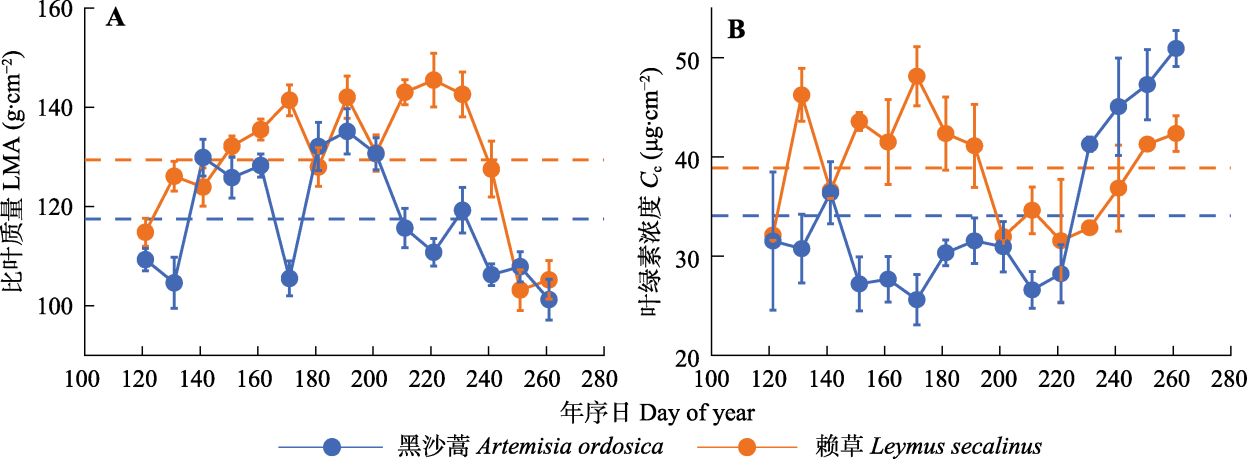
Fig. 3 Seasonal dynamics of leaf functional traits of Artemisia ordosica and Leymus secalinus in Mau Us Sandy Land in 2021 (mean ± SD). The horizontal lines represent the mean values. Cc, leaf chlorophyll content; LMA, leaf mass per unit area.
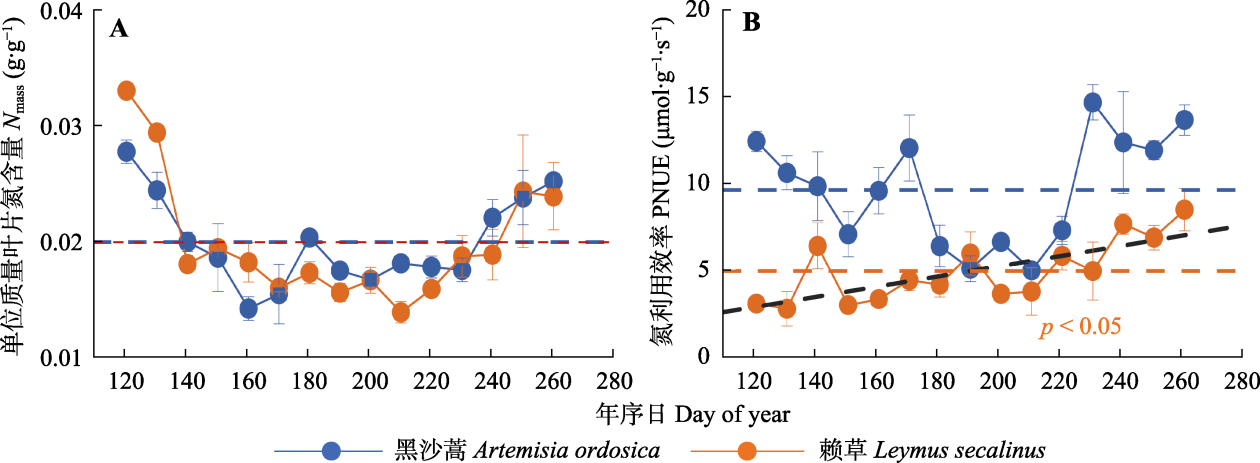
Fig. 4 Seasonal dynamics of leaf nitrogen content per unit mass (Nmass) and photosynthetic nitrogen use efficiency (PNUE) of Artemisia ordosica and Leymus secalinus in Mau Us Sandy Land in 2021 (mean ± SD). The horizontal lines represent the mean values. The black dashed line in B is a trend-fit line for PNUE of L. secalinus.
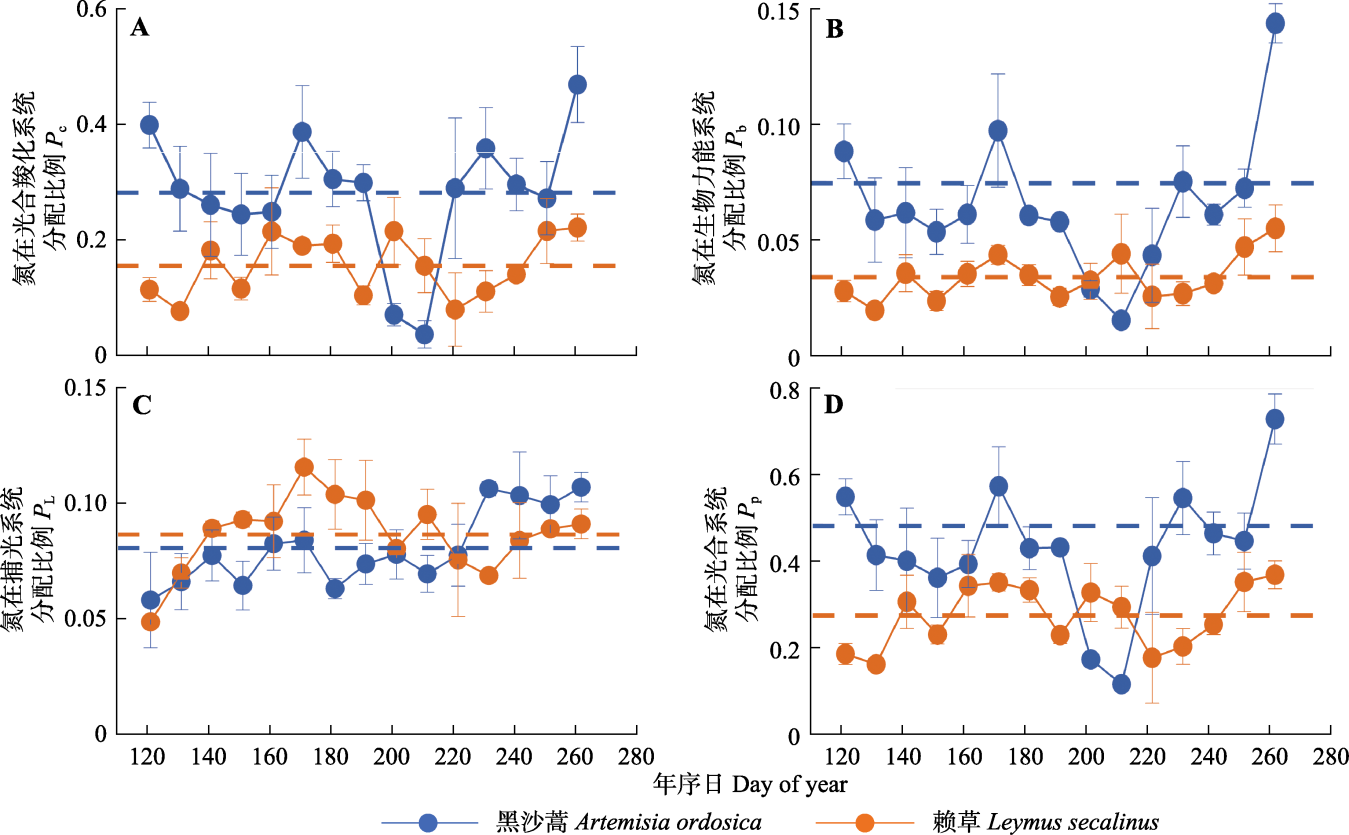
Fig. 5 Seasonal dynamics of leaf nitrogen allocation parameters of Artemisia ordosica and Leymus secalinus in Mau Us Sandy Land in 2021 (mean ± SD). The horizontal lines represent the mean values. Pc, nitrogen distribution in carboxylation system; Pb, nitrogen distribution in bioenergy system; PL, nitrogen distribution in light capture system; Pp, distribution proportion of leaf nitrogen in photosynthetic system.
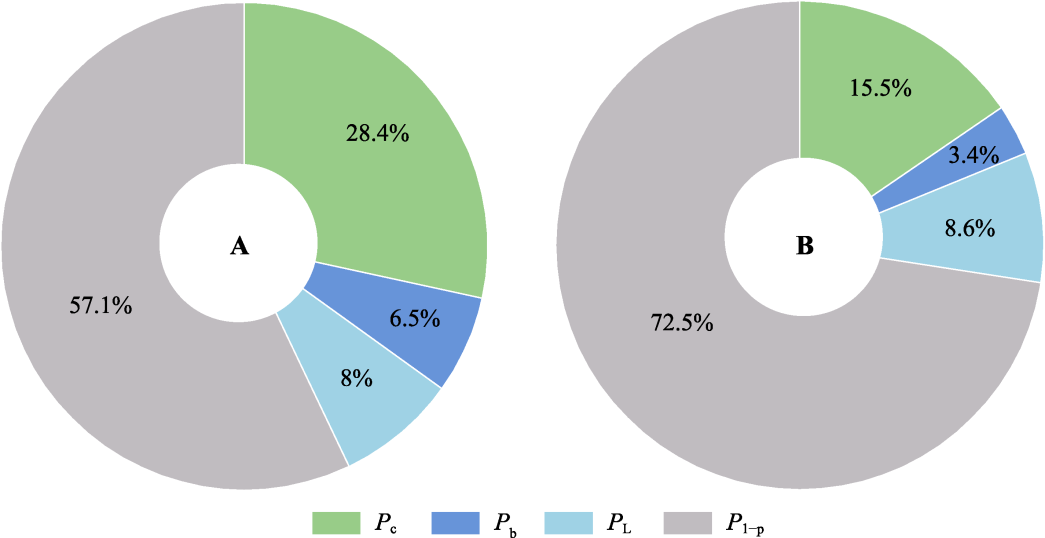
Fig. 6 Proportion of leaf nitrogen allocation of of Artemisia ordosica (A) and Leymus secalinus (B) in Mau Us Sandy Land in 2021. Pc, nitrogen distribution in carboxylation system; Pb, nitrogen distribution in bioenergy system; PL, nitrogen distribution in light capture system; P1-p, distribution proportion of leaf nitrogen in non-photosynthetic system.
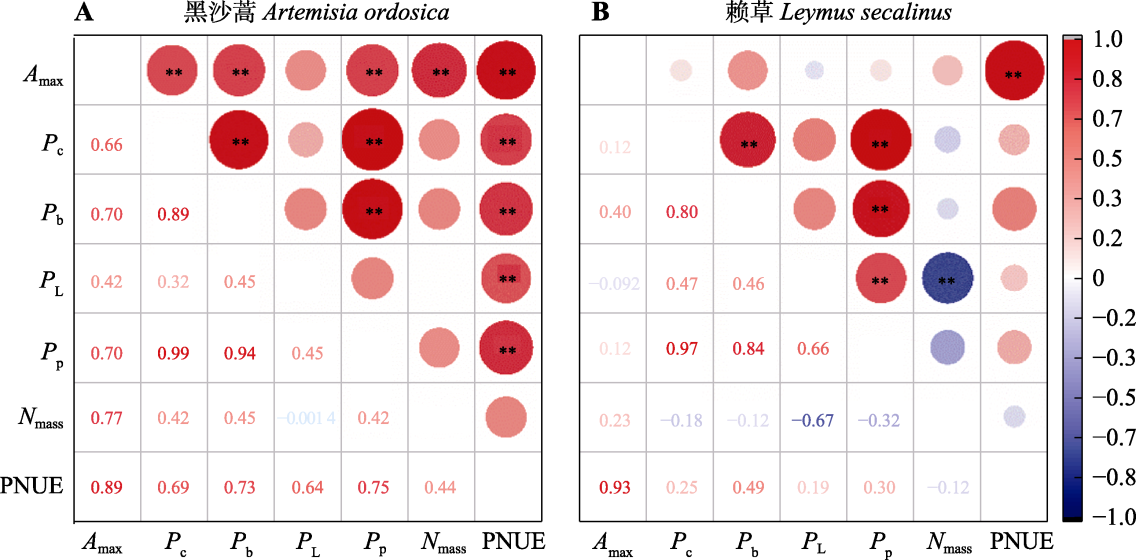
Fig. 7 Correlations between the maximum net photosynthetic rate and parameters related to leaf nitrogen content of Artemisia ordosica and Leymus secalinus in Mau Us Sandy Land in 2021. Amax, the maximum net photosynthetic rate; Nmass, nitrogen content of leaf per unit mass; Pb, leaf nitrogen distribution in bioenergy system; Pc, leaf nitrogen distribution in carboxylation system; PL, leaf nitrogen distribution in light capture system; PNUE, photosynthetic nitrogen use efficiency; Pp, distribution proportion of leaf nitrogen in photosynthetic system. *, p ≤ 0.05; **, p ≤ 0.01. The circle size represents the absolute magnitude of the correlation coefficient, while the color indicates its direction (positive/negative).
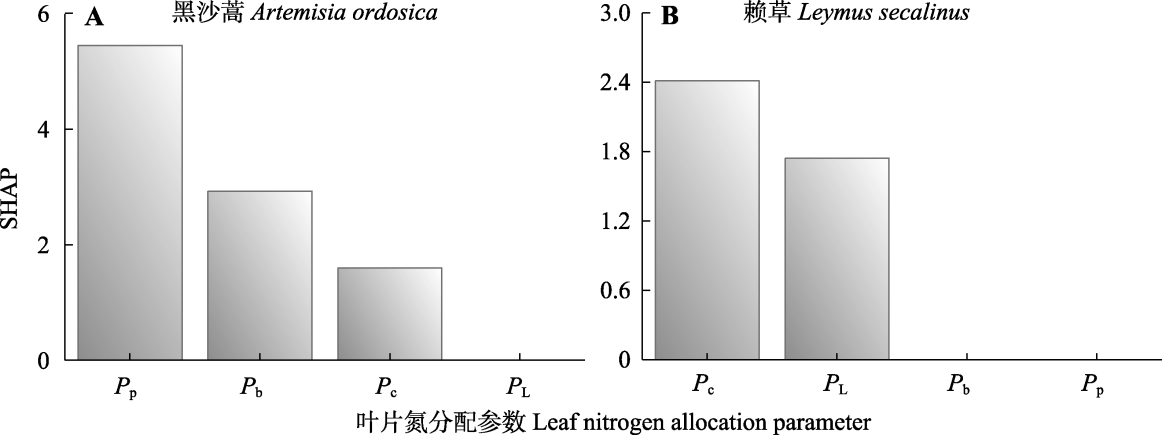
Fig. 8 The SHAP values of leaf nitrogen allocation parameters affecting the seasonal variation of the maximum net photosynthetic rate of Artemisia ordosica and Leymus secalinus in Mau Us Sandy Land in 2021. Pb, nitrogen distribution in bioenergy system; Pc, nitrogen distribution in carboxylation system; PL, nitrogen distribution in light capture system; Pp, distribution proportion of leaf nitrogen in photosynthetic system.
| 自变量 Independent variable | 间接通径系数 Indirect path coefficient |
|---|---|
| 氮在生物力能学组分中的比例 Pp | 0.38 (Pp→Pc→Amax) |
| 0.43 (Pp→Pb→Amax) | |
| 氮在生物力能学组分中的比例 Pb | 0.34 (Pb→Pc→Amax) |
| 氮在羧化系统中的比例 Pc | 0.41 (Pc→Pb→Amax) |
| 氮在捕光系统中分配比例 PL | 0.20 (PL→Pb→Amax) |
Table 1 Indirect path coefficients of nitrogen allocation factors on the maximum net photosynthetic rate (Amax) of Artemisia ordosica and Leymus secalinus
| 自变量 Independent variable | 间接通径系数 Indirect path coefficient |
|---|---|
| 氮在生物力能学组分中的比例 Pp | 0.38 (Pp→Pc→Amax) |
| 0.43 (Pp→Pb→Amax) | |
| 氮在生物力能学组分中的比例 Pb | 0.34 (Pb→Pc→Amax) |
| 氮在羧化系统中的比例 Pc | 0.41 (Pc→Pb→Amax) |
| 氮在捕光系统中分配比例 PL | 0.20 (PL→Pb→Amax) |

Fig. 9 Relationships between the maximum net photosynthetic rate (Amax), nitrogen content of leaf per unit mass (Nmass), distribution proportion of leaf nitrogen in photosynthetic system (Pp), photosynthetic nitrogen use efficiency (PNUE) and soil water content at 10 cm depth (SWC10) of Artemisia ordosica and Leymus secalinus in Mau Us Sandy Land in 2021. The shaded area represents the 95% confidence interval.
| [1] | Akram MA, Wang X, Shrestha N, Zhang YH, Sun Y, Yao S, Li JH, Hou QQ, Hu WG, Ran JZ (2023). Variations and driving factors of leaf functional traits in the dominant desert plant species along an environmental gradient in the drylands of China. Science of the Total Environment, 897, 165394. DOI: 10.1016/j.scitotenv.2023.165394. |
| [2] | Ali AA, Xu C, Rogers A, Fisher RA, Wullschleger SD, Massoud EC, Vrugt JA, Muss JD, McDowell NG, Fisher JB, Reich PB, Wilson CJ (2016). A global scale mechanistic model of photosynthetic capacity (LUNA V1.0). Geoscientific Model Development, 9, 587-606. |
| [3] | Bao PA, Qiu KY, Huang YY, Liu WS, Cui LY, Wang SY, Yang Y, Xie YZ (2023). Effects of nitrogen and phosphorus additions on litter decomposition characteristics of two grass species in Stipa breviflora desert steppe. Chinese Journal of Grassland, 45(9), 66-76. |
| [鲍平安, 邱开阳, 黄业芸, 刘王锁, 崔璐瑶, 王思瑶, 杨壹, 谢应忠 (2023). 氮磷添加对短花针茅荒漠草原两种禾草凋落物分解特征的影响. 中国草地学报, 45(9), 66-76.] | |
| [4] |
Biederman JA, Scott RL, Bell TW, Bowling DR, Dore S, Garatuza-Payan J, Kolb TE, Krishnan P, Krofcheck DJ, Litvak ME, Maurer GE, Meyers TP, Oechel WC, Papuga SA, Ponce-Campos GE, et al.(2017). CO2 exchange and evapotranspiration across dryland ecosystems of southwestern North America. Global Change Biology, 23, 4204-4221.
DOI PMID |
| [5] | Byeon S, Song W, Park M, Kim S, Lee H, Jeon J, Kim K, Lee MS, Lim H, Han SH, Oh C, Kim SH (2021). Down-regulation of photosynthesis and its relationship with changes in leaf N allocation and N availability after long-term exposure to elevated CO2 concentration. Journal of Plant Physiology, 265, 153489. DOI: 10.1016/j.jplph.2021.153489. |
| [6] | Chaves MM, Pereira JS, Maroco J, Rodrigues ML, Ricardo CPP, Osório ML, Carvalho I, Faria T, Pinheiro C (2002). How plants cope with water stress in the field. Photosynthesis and growth. Annals of Botany, 89, 907-916. |
| [7] | Chen GY, Chen J, Xu DQ (2010). Thinking about the relationship between net photosynthetic rate and intercellular CO2 concentration. Plant Physiology Journal, 46(1), 64-66. |
| [陈根云, 陈娟, 许大全 (2010). 关于净光合速率和胞间CO2浓度关系的思考. 植物生理学通讯, 46(1), 64-66.] | |
| [8] | Chen TQ, Xu GQ, Liu SS, Li Y (2023). Hydraulic traits adjustments and nonstructural carbohydrate dynamics of Haloxylon ammodendron under drought stress. Chinese Journal of Plant Ecology, 47, 1407-1421. |
|
[陈图强, 徐贵青, 刘深思, 李彦 (2023). 干旱胁迫下梭梭水力性状调整与非结构性碳水化合物动态. 植物生态学报, 47, 1407-1421.]
DOI |
|
| [9] | Chen ZH, Guo JB, Zha TS, Qin SG, Tang SL, Jia X (2014). Seasonal variation and water response of leaf nitrogen content for three psammophytic shrub species. Journal of Arid Land Resources and Environment, 28(6), 63-67. |
| [陈志豪, 郭建斌, 查天山, 秦树高, 唐思凌, 贾昕 (2014). 三种沙生灌木叶片含氮量的季节变化及其水分响应. 干旱区资源与环境, 28(6), 63-67.] | |
| [10] | Cowan T, Undorf S, Hegerl GC, Harrington LJ, Otto FEL (2020). Present-day greenhouse gases could cause more frequent and longer Dust Bowl heatwaves. Nature Climate Change, 10, 505-510. |
| [11] |
Ding L, Lu ZF, Gao LM, Guo SW, Shen QR (2018). Is nitrogen a key determinant of water transport and photosynthesis in higher plants upon drought stress? Frontiers in Plant Science, 9, 1143. DOI: 10.3389/fpls.2018.01143.
PMID |
| [12] | Duursma RA (2015). Plantecophys—An R package for analysing and modelling leaf gas exchange data. PLoS ONE, 10, e0143346. DOI: 10.1371/journal.pone.0143346. |
| [13] | Fan JZ, Wang D, Hu YL, Jing PP, Wang PP, Chen JQ (2016). Optimal stomatal behavior theory for simulating stomatal conductance. Chinese Journal of Plant Ecology, 40, 631-642. |
|
[范嘉智, 王丹, 胡亚林, 景盼盼, 王朋朋, 陈吉泉 (2016). 最优气孔行为理论和气孔导度模拟. 植物生态学报, 40, 631-642.]
DOI |
|
| [14] |
Farquhar GD, von Caemmerer S, Berry JA (1980). A biochemical model of photosynthetic CO2 assimilation in leaves of C3 species. Planta, 149, 78-90.
DOI PMID |
| [15] | Feng XF, Lei CY, Zhang YJ, Xiang D, Yang MF, Zhang WF, Zhang YL (2023). Effect of leaf nitrogen allocation on photosynthetic nitrogen use efficiency at flowering and boll stage of Gossypium spp. Chinese Journal of Plant Ecology, 47, 1600-1610. |
|
[冯旭飞, 雷长英, 张玉洁, 向导, 杨明凤, 张旺锋, 张亚黎 (2023). 棉花花铃期叶片氮分配对光合氮利用效率的影响. 植物生态学报, 47, 1600-1610.]
DOI |
|
| [16] | Feng YL, Lei YB, Wang RF, Callaway RM, Valiente-Banuet A, Inderjit, Li YP, Zheng YL (2009). Evolutionary tradeoffs for nitrogen allocation to photosynthesis versus cell walls in an invasive plant. Proceedings of the National Academy of Sciences of the United States of America, 106, 1853-1856. |
| [17] | Funk JL, Glenwinkel LA, Sack L (2013). Differential allocation to photosynthetic and non-photosynthetic nitrogen fractions among native and invasive species. PLoS ONE, 8, e64502. DOI: 10.1371/journal.pone.0064502. |
| [18] | Hao SR, Jia X, Mu YM, Zha TS, Qin SG, Liu P, Tian Y, Qi JD, Zhao HX, Li XH (2023). Canopy greenness, atmospheric aridity, and large rain events jointly regulate evapotranspiration partitioning in a temperate semiarid shrubland. Agricultural and Forest Meteorology, 333, 109425. DOI: 10.1016/j.agrformet.2023.109425. |
| [19] | Hu WS, Zhao ML, Zhang SS, Li YS, Dai J, Gu CM, Li XY, Yang L, Qin L, Liao X (2023). Optimized leaf storage and photosynthetic nitrogen trade-off promote synergistic increases in photosynthetic rate and photosynthetic nitrogen use efficiency. Physiologia Plantarum, 175, e14013. DOI: 10.1111/ppl.14013. |
| [20] | Huang TF, Jander G (2017). Abscisic acid-regulated protein degradation causes osmotic stress-induced accumulation of branched-chain amino acids in Arabidopsis thaliana. Planta, 246, 737-747. |
| [21] | Jiang Y, Jin C, Jiang XY, Li XH, Wei NN, Gao SJ, Liu P, Jia X, Zha TS (2022). Relative changes and biophysical controls of leaf resource use efficiencies in Artemisia ordosica. Acta Ecologica Sinica, 42, 6196-6208. |
| [蒋燕, 靳川, 姜晓燕, 李鑫豪, 魏宁宁, 高圣杰, 刘鹏, 贾昕, 查天山 (2022). 油蒿叶片资源利用效率变化及其生物与非生物影响因素. 生态学报, 42, 6196-6208.] | |
| [22] | Jiang Y, Tian Y, Zha TS, Jia X, Bourque CPA, Liu P, Jin C, Jiang XY, Li XH, Wei NN, Gao SJ (2021). Dynamic changes in plant resource use efficiencies and their primary influence mechanisms in a typical desert shrub community. Forests, 12, 1372. DOI:10.3390/f12101372. |
| [23] | Li XH, Yan HJ, Wei TZ, Zhou WJ, Jia X, Zha TS (2019). Relative changes of resource use efficiencies and their responses to environmental factors in Artemisia ordosica during growing season. Chinese Journal of Plant Ecology, 43, 889-898. |
|
[李鑫豪, 闫慧娟, 卫腾宙, 周文君, 贾昕, 查天山 (2019). 油蒿资源利用效率在生长季的相对变化及对环境因子的响应. 植物生态学报, 43, 889-898.]
DOI |
|
| [24] | Liu M, Liu XC, Zhao Y, Korpelainen H, Li CY (2022). Sex-specific nitrogen allocation tradeoffs in the leaves of Populus cathayana cuttings under salt and drought stress. Plant Physiology and Biochemistry, 172, 101-110. |
| [25] | Liu Y, Zhang LN, Liu XH, Zeng XM, Jia RX (2023). Research progress from individual plant physiological response to ecological model prediction under drought stress. Acta Ecologica Sinica, 43, 10042-10053. |
| [刘燕, 张凌楠, 刘晓宏, 曾小敏, 贾瑞萱 (2023). 干旱胁迫植物个体生理响应及其生态模型预测研究进展. 生态学报, 43, 10042-10053.] | |
| [26] |
Luo XZ, Keenan TF, Chen JM, Croft H, Colin Prentice I, Smith NG, Walker AP, Wang H, Wang R, Xu CG, Zhang Y (2021). Global variation in the fraction of leaf nitrogen allocated to photosynthesis. Nature Communications, 12, 4866. DOI:10.1038/s41467-021-25163-9.
PMID |
| [27] | Ma JY, Jia X, Zha TS, Bourque CPA, Tian Y, Bai YJ, Liu P, Yang RZ, Li C, Li CY, Xie J, Yu HQ, Zhang F, Zhou CX (2019). Ecosystem water use efficiency in a young plantation in Northern China and its relationship to drought. Agricultural and Forest Meteorology, 275, 1-10. |
| [28] | Medlyn BE, Dreyer E, Ellsworth D, Forstreuter M, Harley PC, Kirschbaum MUF, Le Roux X, Montpied P, Strassemeyer J, Walcroft A, Wang K, Loustau D (2002). Temperature response of parameters of a biochemically based model of photosynthesis. II. A review of experimental data. Plant, Cell & Environment, 25, 1167-1179. |
| [29] | Moon M, Kang KS, Park IK, Kim T, Kim HS (2015). Effects of leaf nitrogen allocation on the photosynthetic nitrogen-use efficiency of seedlings of three tropical species in Indonesia. Journal of the Korean Society for Applied Biological Chemistry, 58, 511-519. |
| [30] |
Mu XH, Chen QW, Chen FJ, Yuan LX, Mi GH (2016). Within-leaf nitrogen allocation in adaptation to low nitrogen supply in maize during grain-filling stage. Frontiers in Plant Science, 7, 699. DOI: 10.3389/fpls.2016.00699.
PMID |
| [31] | Mu YM, Yuan Y, Jia X, Zha TS, Qin SG, Ye ZQ, Liu P, Yang RZ, Tian Y (2022). Hydrological losses and soil moisture carryover affected the relationship between evapotranspiration and rainfall in a temperate semiarid shrubland. Agricultural and Forest Meteorology, 315, 108831. DOI: 10.1016/j.agrformet.2022.108831. |
| [32] | Niinemets Ü, Tenhunen JD (1997). A model separating leaf structural and physiological effects on carbon gain along light gradients for the shade-tolerant species Acer saccharum. Plant, Cell & Environment, 20, 845-866. |
| [33] | Onoda Y, Hikosaka K, Hirose T (2004). Allocation of nitrogen to cell walls decreases photosynthetic nitrogen-use efficiency. Functional Ecology, 18, 419-425. |
| [34] | Park M, Cho S, Park J, Lee H, Song W, Park IK, Kim HS (2019). Size-dependent variation in leaf functional traits and nitrogen allocation trade-offs in Robinia pseudoacacia and Cornus controversa. Tree Physiology, 39, 755-766. |
| [35] | Qing H, Cai Y, Xiao Y, Yao YH, An SQ (2012). Leaf nitrogen partition between photosynthesis and structural defense in invasive and native tall form Spartina alterniflora populations: effects of nitrogen treatments. Biological Invasions, 14, 2039-2048. |
| [36] | Quebbeman JA, Ramirez JA (2016). Optimal allocation of leaf-level nitrogen: implications for covariation of Vcmax and Jmax and photosynthetic downregulation. Journal of Geophysical Research: Biogeosciences, 121, 2464-2475. |
| [37] | Reich PB, Sendall KM, Stefanski A, Rich RL, Hobbie SE, Montgomery RA (2018). Effects of climate warming on photosynthesis in boreal tree species depend on soil moisture. Nature, 562, 263-267. |
| [38] | Rodell M, Li BL (2023). Changing intensity of hydroclimatic extreme events revealed by GRACE and GRACE-FO. Nature Water, 1, 241-248. |
| [39] |
Schimel DS (2010). Drylands in the earth system. Science, 327, 418-419.
DOI PMID |
| [40] | Shi ZM, Tang JC, Cheng RM, Luo D, Liu SR (2015). A review of nitrogen allocation in leaves and factors in its effects. Acta Ecologica Sinica, 35, 5909-5919. |
| [史作民, 唐敬超, 程瑞梅, 罗达, 刘世荣 (2015). 植物叶片氮分配及其影响因子研究进展. 生态学报, 35, 5909-5919.] | |
| [41] | Simonin KA, Limm EB, Dawson TE (2012). Hydraulic conductance of leaves correlates with leaf lifespan: implications for lifetime carbon gain. New Phytologist, 193, 939-947. |
| [42] | Song JX, Zhou S, Yu BF, Li Y, Liu YX, Yao Y, Wang S, Fu BJ (2024). Serious underestimation of reduced carbon uptake due to vegetation compound droughts. NPJ Climate and Atmospheric Science, 7, 23. DOI: 10.1038/s41612-024-00571-y. |
| [43] | Takashima T, Hikosaka K, Hirose T (2004). Photosynthesis or persistence: nitrogen allocation in leaves of evergreen and deciduous Quercus species. Plant, Cell & Environment, 27, 1047-1054. |
| [44] | Tateno R, Kawaguchi H (2002). Differences in nitrogen use efficiency between leaves from canopy and subcanopy trees. Ecological Research, 17, 695-704. |
| [45] | Trouwborst G, Hogewoning SW, Harbinson J, van Ieperen W (2011). Photosynthetic acclimation in relation to nitrogen allocation in cucumber leaves in response to changes in irradiance. Physiologia Plantarum, 142, 157-169. |
| [46] | van Ommen Kloeke AEE, Douma JC, Ordoñez JC, Reich PB, van Bodegom PM (2012). Global quantification of contrasting leaf life span strategies for deciduous and evergreen species in response to environmental conditions. Global Ecology and Biogeography, 21, 224-235. |
| [47] | Wei XW, Yang YH, Yao JL, Han JY, Yan M, Zhang JW, Shi YJ, Wang JF, Mu CS (2022). Improved utilization of nitrate nitrogen through within-leaf nitrogen allocation trade-offs in Leymus chinensis. Frontiers in Plant Science, 13, 870681. DOI: 10.3389/fpls.2022.870681. |
| [48] | Werner C, Correia O, Beyschlag W (1999). Two different strategies of Mediterranean macchia plants to avoid photoinhibitory damage by excessive radiation levels during summer drought. Acta Oecologica, 20, 15-23. |
| [49] |
Wright IJ, Reich PB, Cornelissen JHC, Falster DS, Garnier E, Hikosaka K, Lamont BB, Lee W, Oleksyn J, Osada N, Poorter H, Villar R, Warton DI, Westoby M (2005). Assessing the generality of global leaf trait relationships. New Phytologist, 166, 485-496.
DOI PMID |
| [50] | Xiao CW, Zhou GS, Ma FY (2002). Effects of water application on morphology and growth of dominant plants in Mu Us Sandy Land. Acta Phytoecologica Sinica, 26, 69-76. |
| [肖春旺, 周广胜, 马风云 (2002). 施水量变化对毛乌素沙地优势植物形态与生长的影响. 植物生态学报, 26, 69-76.] | |
| [51] | Xu MZ, Liu P, Tian Y, Zhao HX, Jin C, Li ML, Mao J, Wei XS, Jia X, Zha TS (2023). Seasonal response of light use efficiency of Artemisia ordosica to leaf traits in Mu Us sandy land. Acta Ecologica Sinica, 43, 5122-5136. |
| [徐铭泽, 刘鹏, 田赟, 赵洪贤, 靳川, 李满乐, 毛军, 魏晓帅, 贾昕, 查天山 (2023). 毛乌素沙地油蒿叶性状对光能利用效率动态的影响. 生态学报, 43, 5122-5136.] | |
| [52] | Yan S, Zhang L, Jing YS, He HL, Yu GR (2014). Variability of the relationship between maximum carboxylation rate of plant leaves and leaf nitrogen content. Chinese Journal of Plant Ecology, 38, 640-652. |
|
[闫霜, 张黎, 景元书, 何洪林, 于贵瑞 (2014). 植物叶片最大羧化速率与叶氮含量关系的变异性. 植物生态学报, 38, 640-652.]
DOI |
|
| [53] | Yang W, Sun JY, Wang JM, Xue YY (2019). Rejuvenation technology of degraded aerial sowing shrubs in Mu Us sandy land of Yulin desert area. Protection Forest Science and Technology, (2), 1-2. |
| [杨伟, 孙婧瑜, 王建梅, 薛园园 (2019). 毛乌素沙地榆林沙区退化飞播灌木林平茬复壮效果分析. 防护林科技, (2), 1-2.] | |
| [54] | Ye ZP (2010). A review on modeling of responses of photosynthesis to light and CO2. Chinese Journal of Plant Ecology, 34, 727-740. |
|
[叶子飘 (2010). 光合作用对光和CO2响应模型的研究进展. 植物生态学报, 34, 727-740.]
DOI |
|
| [55] | Ye ZP, Suggett DJ, Robakowski P, Kang HJ (2013). A mechanistic model for the photosynthesis-light response based on the photosynthetic electron transport of photosystem II in C3 and C4 species. New Phytologist, 199, 110-120. |
| [56] | Ye ZP, Yu Q (2007). Comparison of a new model of light response of photosynthesis with traditional models. Journal of Shenyang Agricultural University, 38, 771-775. |
| [叶子飘, 于强 (2007). 一个光合作用光响应新模型与传统模型的比较. 沈阳农业大学学报, 38, 771-775.] | |
| [57] | Ye ZP, Yu Q (2008). A coupled model of stomatal conductance and photosynthesis for winter wheat. Photosynthetica, 46, 637-640. |
| [58] | Yu XJ, Zhang LX, Zhou TJ, Zheng JH (2024). Assessing the performance of CMIP6 models in simulating droughts across global drylands. Advances in Atmospheric Sciences, 41, 193-208. |
| [59] |
Yuan Y, Mu YM, Deng YJ, Li XH, Jiang XY, Gao SJ, Zha TS, Jia X (2022). Effects of vegetation coverage and phenological changes on total primary productivity of typical Artemisia nigra shrub ecosystem. Chinese Journal of Plant Ecology, 46, 162-175.
DOI |
|
[原媛, 母艳梅, 邓钰洁, 李鑫豪, 姜晓燕, 高圣杰, 查天山, 贾昕 (2022). 植被覆盖度和物候变化对典型黑沙蒿灌丛生态系统总初级生产力的影响. 植物生态学报, 46, 162-175.]
DOI |
|
| [60] | Zhao HX, Zhang YJ, Xu MZ, Wei TZ, Mao J, Luo Y, Jia X, Zha TS (2022). Effects of leaf nitrogen allocation on seasonal variation in maximum net photosynthetic rate in Artemisia ordosica. Acta Ecologica Sinica, 42, 7156-7166. |
| [赵洪贤, 张洋军, 徐铭泽, 卫腾宙, 毛军, 雒宇, 贾昕, 查天山 (2022). 油蒿叶片氮分配对其最大净光合速率季节变异的影响. 生态学报, 42, 7156-7166.] | |
| [61] | Zheng HL, Huang ZC, Dong XJ (1992). Physiological and ecological study of Artemisia ulgensis and Caryophyllum borealis in Mu Us Sandy Land. Acta Phytoecologica et Geobotanica Sinica, 16, 197-208. |
| [郑海雷, 黄子琛, 董学军 (1992). 毛乌素沙地油蒿和牛心朴子生理生态学研究. 植物生态学与地植物学学报, 16, 197-208.] | |
| [62] |
Zhong C, Jian SF, Huang J, Jin QY, Cao XC (2019). Trade-off of within-leaf nitrogen allocation between photosynthetic nitrogen-use efficiency and water deficit stress acclimation in rice (Oryza sativa L.). Plant Physiology and Biochemistry, 135, 41-50.
DOI PMID |
| [63] | Zhou YJ, Li X, Chen GY (2023). Research progress in plant Rubisco. Scientia Sinica (Vitae), 53, 1213-1229. |
| [周昱婕, 李霞, 陈根云 (2023). 植物Rubisco研究进展. 中国科学: 生命科学, 53, 1213-1229.] | |
| [64] | Zhuang J, Zhou L, Wang YL, Chi YG (2021). Nitrogen allocation regulates the relationship between maximum carboxylation rate and chlorophyll content along the vertical gradient of subtropical forest canopy. Agricultural and Forest Meteorology, 307, 108512. DOI: 10.1016/j.agrformet.2021.108512. |
| [65] | Zhuo H, Liu XY, Luo S, Ou XX, Rong XM, Yang L, Li Q, Han YL (2024). Physiological changes underlying increased photosynthetic-nitrogen use efficiency in response to low-nitrogen conditions in Brassica napus L. Industrial Crops and Products, 211, 118240. DOI: 10.1016/j.indcrop.2024.118240. |
| [1] | MIAO Chun, LIU Liang, ZHU Guan-Nan, BAI Yu-Xuan, SHE Wei-Wei, QIN Shu-Gao, GUO Yan-Pei, ZHANG Yu-Qing. Effects of Artemisia ordosica on the nitrogen uptake rate and proportion of associated herbaceous plants in the Mau Us Sandy Land [J]. Chin J Plant Ecol, 2025, 49(3): 446-459. |
| [2] | ZHANG Fu-Chong, YU Ming-Han, ZHANG Jian-Ling, WANG Ping, DING Guo-Dong, HE Ying-Ying, SUN Hui-Yuan. Synergistic response mechanisms in xylem and phloem of Artemisia ordosica to changes in precipitation [J]. Chin J Plant Ecol, 2024, 48(7): 903-914. |
| [3] | XU Ming-Ze, ZHAO Hong-Xian, LI Cheng, LI Man-Le, TIAN Yun, LIU Peng, ZHA Tian-Shan. Characteristics of seasonal leaf trait network and its drivers in Artemisia ordosica in the Mau Us Sandy Land [J]. Chin J Plant Ecol, 2024, 48(12): 1650-1665. |
| [4] | MA Bin, SHE Wei-Wei, QIN Huan, XUAN Rui-Zhi, SONG Chun-Yang, YUAN Xin-Yue, MIAO Chun, LIU Liang, FENG Wei, QIN Shu-Gao, ZHANG Yu-Qing. Effects of nitrogen and water addition on seed functional traits of Artemisia ordosica [J]. Chin J Plant Ecol, 2024, 48(12): 1637-1649. |
| [5] | FENG Xu-Fei, LEI Zhang-Ying, ZHANG Yu-Jie, XIANG Dao, YANG Ming-Feng, ZHANG Wang-Feng, ZHANG Ya-Li. Effect of leaf nitrogen allocation on photosynthetic nitrogen use efficiency at flowering and boll stage of Gossypium spp. [J]. Chin J Plant Ecol, 2023, 47(11): 1600-1610. |
| [6] | HAN Cong, LIU Peng, MU Yan-Mei, YUAN Yuan, HAO Shao-Rong, TIAN Yun, ZHA Tian-Shan, JIA Xin. Response of ecosystem carbon balance to asymmetric daytime vs nighttime warming in Artemisia ordosica shrublands [J]. Chin J Plant Ecol, 2022, 46(12): 1473-1485. |
| [7] | DAI Yuan-Meng, LI Man-Le, XU Ming-Ze, TIAN Yun, ZHAO Hong-Xian, GAO Sheng-Jie, HAO Shao-Rong, LIU Peng, JIA Xin, ZHA Tian-Shan. Leaf traits of Artemisia ordosica at different dune fixation stages in Mau Us Sandy Land [J]. Chin J Plant Ecol, 2022, 46(11): 1376-1387. |
| [8] | GUI Zi-Yang, QIN Shu-Gao, HU Zhao, BAI Feng, SHI Hui-Shu, ZHANG Yu-Qing. Foliar condensate absorption and its pathways of two typical shrub species in the Mu Us Desert [J]. Chin J Plant Ecol, 2021, 45(6): 583-593. |
| [9] | ZHANG Zhi-Guo, WEI Hai-Xia. Variations of leaf construction cost and leaf traits within the species of Artemisia ordosica along a precipitation gradient in the Mau Us sandy land [J]. Chin J Plant Ecol, 2019, 43(11): 979-987. |
| [10] | LI Xin-Hao, YAN Hui-Juan, WEI Teng-Zhou, ZHOU Wen-Jun, JIA Xin, ZHA Tian-Shan. Relative changes of resource use efficiencies and their responses to environmental factors in Artemisia ordosica during growing season [J]. Chin J Plant Ecol, 2019, 43(10): 889-898. |
| [11] | ZHU Qi-Lin, XIANG Rui, TANG Li, LONG Guang-Qiang. Effects of intercropping on photosynthetic rate and net photosynthetic nitrogen use efficiency of maize under nitrogen addition [J]. Chin J Plan Ecolo, 2018, 42(6): 672-680. |
| [12] | CHEN Wei-Ying, CHEN Zhen-Yong, LUO Fu-Yan, PENG Zheng-Song, YU Mao-Qun. Comparison between modified exponential model and common models of light-response curve [J]. Chin J Plant Ecol, 2012, 36(12): 1277-1285. |
| [13] | ZHOU Ya-Dan, CHEN Shi-Ping, SONG Wei-Min, LU Qi, LIN Guang-Hui. Water-use strategies of two desert plants along a precipitation gradient in northwestern China [J]. Chin J Plant Ecol, 2011, 35(8): 789-800. |
| [14] | WEI Ya-Fen, FANG Jie, ZHAO Xue-Yong, LI Sheng-Gong. Eco-physiological traits of different-age needles of Pinus sylvestrisvar.mongolica plantation in Horqin sandy land of China [J]. Chin J Plant Ecol, 2011, 35(12): 1271-1280. |
| [15] | YE Zi-Piao, YU Qiang. COMPARISON OF NEW AND SEVERAL CLASSICAL MODELS OF PHOTOSYNTHESIS IN RESPONSE TO IRRADIANCE [J]. Chin J Plant Ecol, 2008, 32(6): 1356-1361. |
| Viewed | ||||||
|
Full text |
|
|||||
|
Abstract |
|
|||||
Copyright © 2022 Chinese Journal of Plant Ecology
Tel: 010-62836134, 62836138, E-mail: apes@ibcas.ac.cn, cjpe@ibcas.ac.cn